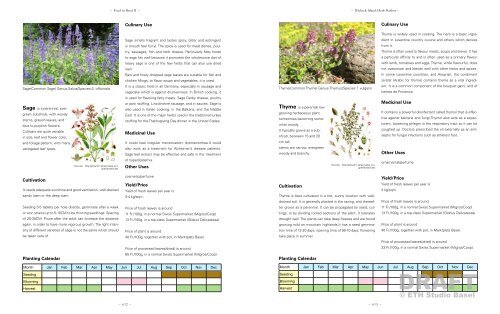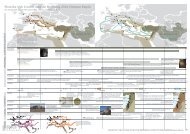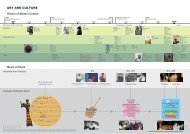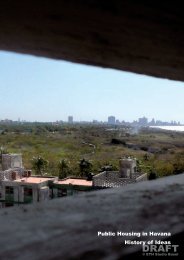BASEL-STADT: 4 PRoPoSALS - ETH Basel
BASEL-STADT: 4 PRoPoSALS - ETH Basel
BASEL-STADT: 4 PRoPoSALS - ETH Basel
You also want an ePaper? Increase the reach of your titles
YUMPU automatically turns print PDFs into web optimized ePapers that Google loves.
Sage(Common Sage) Genus:Salvia/Species:S. officinalis<br />
Sage is a perennial, evergreen<br />
subshrub, with woody<br />
stems, grayish leaves, and<br />
blue to purplish flowers.<br />
Cultivars are quite variable<br />
in size, leaf and flower color,<br />
and foliage pattern, with many<br />
variegated leaf types.<br />
Cultivation<br />
It needs adequate sunshine and good ventilation, well-drained<br />
sandy loam or the deep loam.<br />
Seeding 3-5 tablets per hole directly, germinate after a week<br />
or won strains up to 5-10CM to be thinning seedlings. Spacing<br />
of 20-30CM. Prune after the adult can increase the distance<br />
again, in order to have more vigorous growth. The light intensity<br />
of different varieties of sage is not the same which should<br />
be taken care of.<br />
Planting Calendar<br />
– Food in <strong>Basel</strong> II – – Klybeck Island: Herb Harbor –<br />
Month Jan Feb Mar Apr May Jun Jul Aug Sep Oct Nov Dec<br />
Seeding<br />
Blooming<br />
Harvest<br />
Source: http://pharm1.pharmazie.unigreifswald.de/<br />
Culinary Use<br />
Sage smells fragrant and tastes spicy, bitter and astringent<br />
is (mouth feel furry). The spice is used for meat dishes, poultry,<br />
sausages, fish and herb cheese. Particularly fatty foods<br />
to sage fits well because it promotes the wholesome diet of<br />
heavy sage is one of the few herbs that can also use dried<br />
well.<br />
Raw and finely chopped sage leaves are suitable for fish and<br />
chicken fillings, to flavor soups and vegetables, it is used.<br />
It is a classic herb in all Germany, especially in sausage and<br />
sagecake which is against drunkenness. In British cooking, it<br />
is used for flavoring fatty meats, Sage Derby cheese, poultry<br />
or pork stuffing, Lincolnshire sausage, and in sauces. Sage is<br />
also used in Italian cooking, in the Balkans, and the Middle<br />
East. It is one of the major herbs used in the traditional turkey<br />
stuffing for the Thanksgiving Day dinner in the United States.<br />
Medicinal Use<br />
It could heal irregular menstruation; dysmenorrhea.It could<br />
also work as a treatment for Alzheimer’s disease patients.<br />
Sage leaf extract may be effective and safe in the treatment<br />
of hyperlipidemia.<br />
Other Uses<br />
cosmetic/perfume<br />
Yield/Price<br />
Yield of fresh leaves per year is<br />
3-4 kg/sqm.<br />
Price of fresh leaves is around<br />
11 Fr./100g, in a normal Swiss Supermarket (Migros/Coop)<br />
13 Fr./100g, in a top-class Supermarket (Globus Delicatessa)<br />
Price of plant is around<br />
40 Fr./100g, together with pot, in Marktplatz <strong>Basel</strong>.<br />
Price of processed leaves(dried) is around<br />
65 Fr./100g, in a normal Swiss Supermarket (Migros/Coop).<br />
Thyme(Common Thyme) Genus:Thymus/Species:T. vulgaris<br />
Thyme is a perential low<br />
growing herbaceous plant,<br />
sometimes becoming somewhat<br />
woody.<br />
It typically grows as a subshrub,<br />
between 15 and 20<br />
cm tall.<br />
stems are narrow, evergreen<br />
woody and branchy.<br />
Cultivation<br />
Thyme is best cultivated in a hot, sunny location with welldrained<br />
soil. It is generally planted in the spring, and thereafter<br />
grows as a perennial. It can be propagated by seed, cuttings,<br />
or by dividing rooted sections of the plant. It tolerates<br />
drought well. The plants can take deep freezes and are found<br />
growing wild on mountain highlands.It has a seed germination<br />
time of 12-20 days, ripening time of 90-10 days, flowering<br />
take place in summer.<br />
Planting Calendar<br />
Month Jan Feb Mar Apr May Jun Jul Aug Sep Oct Nov Dec<br />
– 612 – – 613 –<br />
Seeding<br />
Blooming<br />
Harvest<br />
Source: http://pharm1.pharmazie.unigreifswald.de/<br />
Culinary Use<br />
Thyme is widely used in cooking. The herb is a basic ingredient<br />
in Levantine country cuisine and others which derives<br />
from it.<br />
Thyme is often used to flavour meats, soups and stews. It has<br />
a particular affinity to and is often used as a primary flavour<br />
with lamb, tomatoes and eggs. Thyme, while flavourful, does<br />
not overpower and blends well with other herbs and spices.<br />
In some Levantine countries, and Assyrian, the condiment<br />
za’atar (Arabic for thyme) contains thyme as a vital ingredient.<br />
It is a common component of the bouquet garni, and of<br />
herbes de Provence.<br />
Medicinal Use<br />
It contains a powerful disinfectant called thymol that is effective<br />
against bacteria and fungi.Thymol also acts as a expectorant,<br />
loosening phlegm in the respiratory tract so it can be<br />
coughed up. Doctors prescribed the oil externally as an antiseptic<br />
for fungal infections such as athlete’s foot.<br />
Other Uses<br />
ornamental/perfume<br />
Yield/Price<br />
Yield of fresh leaves per year is<br />
3 kg/sqm.<br />
Price of fresh leaves is around<br />
11 Fr./100g, in a normal Swiss Supermarket (Migros/Coop)<br />
13 Fr./100g, in a top-class Supermarket (Globus Delicatessa)<br />
Price of plant is around<br />
40 Fr./100g, together with pot, in Marktplatz <strong>Basel</strong>.<br />
Price of processed leaves(dried) is around<br />
23 Fr./100g, in a normal Swiss Supermarket (Migros/Coop).<br />
DRAFT<br />
© <strong>ETH</strong> Studio <strong>Basel</strong>













